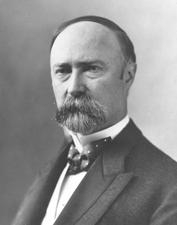Charles Fairbanks
 From Conservapedia
From Conservapedia | Charles Fairbanks | |||
|---|---|---|---|
| |||
| 26th Vice President of the United States From: March 4, 1905 – March 4, 1909 | |||
| President | Theodore Roosevelt | ||
| Predecessor | Theodore Roosevelt | ||
| Successor | James S. Sherman | ||
| Former U.S. Senator from Indiana From: March 4, 1897 – March 3, 1905 | |||
| Predecessor | Daniel W. Voorhees | ||
| Successor | James A. Hemenway | ||
| Information | |||
| Party | Republican | ||
| Spouse(s) | Cornelia Cole Fairbanks | ||
Charles Fairbanks (1852 - 1918) was Theodore Roosevelt's Vice President from 1905 AD to 1909 AD. Fairbanks, Alaska is named in his honor. Before becoming Vice-President Fairbanks was a Senator from Indiana from 1897-1905 [1]
Charles Fairbanks, the son of Loriston Fairbanks and Mary Adelaide Smith, was born in a modest log cabin in Ohio.[2] Loriston Fairbanks was a farmers and a wagon maker who was active member of the Union County, Ohio Agricultural Board, but were considered relatively well off in comparison to their region.
The young Charles Fairbanks attended college at Ohio Wesleyan, graduating eighth in a class of forty four. He went on to receive a law degree from Cleveland Law School, taking only six months to complete all of his courses and pass the bar.[3]
In 1904, now Senator Fairbanks, a close friend to assassinated President McKinley had aspirations for the Presidency and thought the easiest route to fulfilling them would be to serve as then President Roosevelt's Vice President. As such, his supporters made sure to nominate him for the position and were successful.
In 1908, after Roosevelt announced his retirement but decided to hand pick his successor. Roosevelt, held Fairbanks in disdain, often mentioning his choices for successor in front of him, while leaving his name out.[4] Roosevelt initially favored Secretary of State Elihu Root. However, Root's age and background in corporate law did not work in his favor, causing Roosevelt to support his friend and Secretary of War William Howard Taft. Nonetheless, support for Charles Fairbanks remained widespread and far surpassed that of another contender, Charles Evans Hughes, who would win nomination 8 years later.
After leaving office in 1909, Fairbanks returned to Indiana, where he remained only marginally involved in politics. In 1916, his name was put forward again for nomination. This time Charles Evans Hughes was nominated, but Fairbanks was nominated for Vice President on the first ballot,[5] despite his clear request not to be nominated for same. Throughout the campaign of 1916 Charles Evans Hughes and Fairbanks campaigned for a return to the protective tariffs lifted by Wilson. The ticket lost narrowly, but many credit Fairbanks with having kept Indiana in the Republican column.
In the couple of years that followed, Fairbanks remained active in the causes of conservation and actively supported the Liberty Loans campaign for the military. He also made several visits to army bases to encourage the troops. Fairbanks passed away on June 14, 1918 in Indianapolis, Indiana.
References[edit]
- ↑ http://bioguide.congress.gov/scripts/biodisplay.pl?index=F000003
- ↑ Senate History
- ↑ [Herbert J. Rissler, "Charles Warren Fairbanks: Conservative Hoosier," (Ph.D. dissertation, Indiana University, 1961), p. 5-27]
- ↑ Senate History
- ↑ [ibid. Rissler, pp. 265-66]
| |||||
Categories: [Former United States Senators] [Vice Presidents of the United States] [Republican Party]
↧ Download as ZWI file | Last modified: 02/27/2023 09:01:32 | 5 views
☰ Source: https://www.conservapedia.com/Charles_Fairbanks | License: CC BY-SA 3.0
 ZWI signed:
ZWI signed:
 KSF
KSF